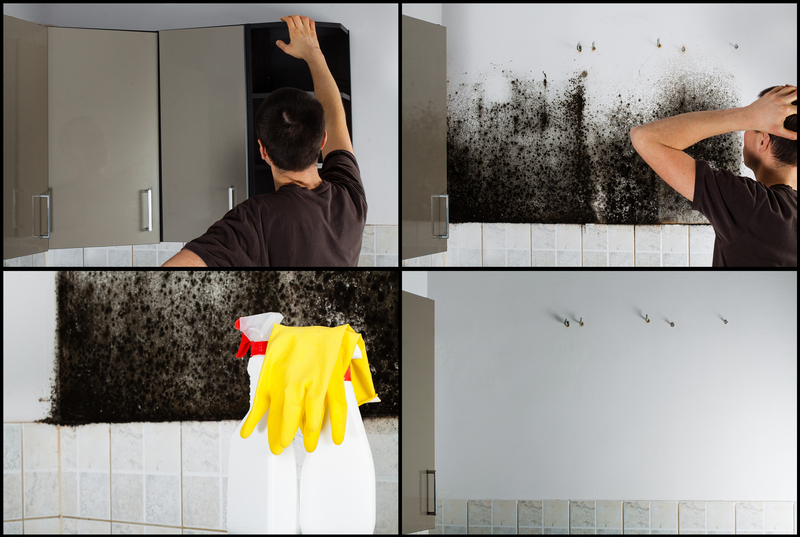Transform Your Kitchen with Pro Oven Cleaning Tips
Posted on 03/11/2025
Transform Your Kitchen with Pro Oven Cleaning Tips
A sparkling clean oven is the heart of a beautiful, functional kitchen. Whether you're a passionate home chef, a busy parent, or someone who simply loves a tidy home, knowing the best oven cleaning tips will help you achieve a fresh, inviting cooking space. In this comprehensive guide, we'll reveal expert oven cleaning secrets to help you restore and maintain your appliance, transforming both your kitchen--and your cooking experience!

Why Is Regular Oven Cleaning So Important?
Many homeowners overlook their oven in favor of more visible kitchen surfaces. However, neglecting to regularly clean your stove has several downsides:
- Reduces the risk of fire: Built-up grease and food debris can ignite and create dangerous flare-ups.
- Prevents unpleasant odors: Residues from old spills can release smells into your kitchen and food.
- Improves taste and air quality: Residues may smoke, affecting meal flavors and filling your home with smoke.
- Enhances oven efficiency: A clean oven heats more evenly, decreasing cooking times and saving energy.
- Extends appliance lifespan: Grease and build-up can cause corrosion and damage critical elements.
Ready to make your kitchen shine? Let's dive into powerful, professional oven cleaning strategies you can use at home.
Getting Started: Essentials for Oven Cleaning
Before you begin, assemble your cleaning toolkit. You'll need:
- Protective gloves (rubber or latex)
- Old towels or newspaper
- Scrubbing sponges and steel wool pads
- Plastic or silicone spatula (for scraping)
- Microfiber cloths
- Baking soda and white vinegar
- A sturdy spray bottle
- Oven-safe bowl if using steam cleaning
- An effective commercial oven cleaner (preferably fume-free and eco-friendly if required)
Tip: Always consult your oven's user manual and follow safety guidelines--for example, never combine ammonia and bleach, and be careful with self-cleaning features!
Pro Oven Cleaning Techniques for a Spotless Finish
1. Self-Cleaning Ovens: What to Know
Many modern ovens include a self-cleaning mode. This feature heats the oven to extremely high temperatures (sometimes over 900?F) to incinerate food residue into ash. Here's how to use it safely:
- Remove racks and accessories: Take out anything not specifically marked safe for self-cleaning.
- Ventilate well: Open windows and doors--self-cleaning cycles may release odors and fumes.
- Follow directions: Refer to your manufacturer's guidelines for cycle length and safety recommendations.
- Clean up ash: After the cycle, allow the oven to cool fully. Wipe away ash residue with a damp cloth.
*Self-cleaning is not for every situation or oven. This feature can sometimes damage components and is not suitable for every oven model.*
2. Classic Deep Clean with Homemade Solutions
If your oven doesn't have self-cleaning or you prefer gentler methods, try this powerful DIY oven cleaning technique:
- Remove oven racks: Set them aside for separate cleaning.
- Create a baking soda paste: Mix 1/2 cup baking soda with a few tablespoons of water to form a spreadable paste.
- Apply the paste: Wearing gloves, smear the paste inside your oven's interior, avoiding elements and vents. Pay special attention to spots with heavy buildup.
- Let it sit: Allow the paste to rest for 12 hours or overnight for the best results.
- Wipe clean: Use a damp cloth or sponge to remove the paste--it'll take grease and grime with it!
- Spray vinegar: For lingering residue, spritz with white vinegar. The fizz helps lift any leftover debris.
- Buff and dry: Wipe down all surfaces with a dry microfiber cloth.
This eco-friendly oven cleaning tip is safe, affordable, and highly effective--even on tough, baked-on messes.
3. Steam Cleaning for Fast Results
Oven steam cleaning is an efficient, chemical-free way to loosen grime:
- Fill an oven-safe bowl with water: Add a few tablespoons of lemon juice or vinegar for extra power.
- Place the bowl in the oven: Heat to 250?F for 30 minutes.
- Turn off oven and let steam sit: Steam will soften stuck-on debris.
- Wipe the interior: Once cool enough, use a damp cloth to remove loosened residue.
This method is particularly useful for quick oven cleaning in between deep cleans!
4. How to Clean Oven Racks Like a Pro
Grimy racks can impair oven performance and flavor. Here's how to restore them:
- Soak racks in the tub: Place racks in your bathtub on an old towel. Cover with hot water and add 1/2 cup dish soap or a few dryer sheets (yes, they help loosen grime!).
- Let sit overnight: The longer the soak, the easier the scrub.
- Scrub and rinse: Use a non-abrasive sponge or brush to remove loosened grease, then rinse thoroughly and dry.
5. Tackling Oven Glass Doors
Burn marks and splatters can make your oven door appear permanently stained. Try this method:
- Make a paste: Combine baking soda and water.
- Spread onto glass: Let sit for 30-60 minutes.
- Wipe away: Use a soft damp cloth to remove residue, then buff dry for a streak-free shine.
For dual-pane (double glass) doors, use a narrow duster or specialist cleaning tool--refer to the manual for specifics. *Be gentle; never use sharp blades on glass!*
Expert Kitchen Oven Cleaning Tips & Tricks
- Prevent spills: Use oven-safe mats or line under racks with parchment paper to catch drips. Never use aluminum foil on the floor of the oven.
- Clean as you go: Wipe fresh spills with a damp cloth as soon as the oven cools--easier than tackling baked-on messes later!
- Deodorize naturally: Simmer a bowl of water with lemon after cleaning to eliminate odors and leave a fresh scent.
- Use the right tools: A toothbrush is perfect for crevices, while a plastic spatula can gently scrape stubborn residue.
- Schedule monthly maintenance: Make oven cleaning part of your routine. Mark your calendar as a reminder!
Choosing the Best Oven Cleaner: Natural vs. Commercial Products
There's no one-size-fits-all approach when it comes to choosing an oven cleaning product. Here's a quick guide:
- Eco-friendly/baking soda cleaners: Safe, non-toxic, and affordable; ideal for light-to-moderate grime.
- Commercial oven cleaners: Effective on heavy, burnt-on grease but some contain harsh chemicals. Always wear gloves and ventilate well. Try fume-free options if sensitive to odors.
- Enzyme-based cleaners: These newer products target organic residues and are often safe for pets and children.
Tip: Always test a new product on a small area before applying broadly.
Troubleshooting Oven Cleaning Challenges
- Stubborn stains won't budge? Repeat the baking soda paste process and leave it for a longer period, or use a commercial degreaser.
- Persistent odors? Clean behind and under your oven as well--hidden debris can smell!
- Drip pans and heating elements dirty? Unplug the oven, remove elements if possible, and clean carefully with a damp cloth (never immerse electrical parts in water!).
Maintaining a Clean Oven Long Term
Prolong that sparkling clean oven with proactive habits:
- Spot clean weekly: Address new messes right away to avoid buildup.
- Monthly deep clean: Use the baking soda/vinegar method for the interior and racks.
- Replace oven liners: If you use liners, replace or clean them monthly.
- Check your oven's exterior: Wipe knobs, handles, and the control panel regularly too.
Bonus: Quick Oven Cleaning Hacks for Busy Kitchens
- Magic eraser sponges: Great for scuff marks on oven exteriors and glass.
- Boiling water method: Pour boiling water over stubborn gunk (with oven off and door open); let it soak and then scrub gently.
- Vinegar and lemon steam: Place a cup of vinegar/lemon water in a hot oven for 20 minutes for easy cleaning and fresh scent.
When to Call a Professional Oven Cleaning Service
Sometimes, the mess is too much or there are technical difficulties. Consider a professional if:
- Your oven hasn't been cleaned in years and is heavily soiled.
- You're worried about damaging sensitive parts or a self-cleaning feature is malfunctioning.
- You have allergies or sensitivities to cleaning products and fumes.
Professionals use specialized tools and non-toxic solutions for deep, safe oven cleaning with minimal disruption to your kitchen routine.

Frequently Asked Questions (FAQ) About Oven Cleaning
How often should I clean my oven?
Aim for a deep clean every three months, or monthly if you cook often. Always spot-clean spills right away.
Are natural cleaning methods as effective as chemical cleaners?
For routine oven cleaning, natural methods like baking soda and vinegar are very effective. For thick, burnt-on grease that's several months old, commercial products may be faster.
Can I use my oven right after cleaning?
Once the oven is cool, wiped dry, and any cleaner residue is removed, you can start cooking again! Let the oven air out if you've used strong chemicals.
Conclusion: Enjoy Your Freshly Transformed Kitchen!
A pristine oven is more than an appliance--it's a sign of a well-loved kitchen and a joy to cook with. By using these pro oven cleaning tips, you'll not only make your kitchen sparkle but also improve the safety, efficiency, and enjoyment of your cooking space.
Don't wait for grime to take over! With the right habits and professional strategies, your oven--and your kitchen--will shine all year long.
Embrace your next culinary adventure with confidence, starting with a clean oven!

 Company name:
Company name:  Telephone:
Telephone:  Opening Hours:
Opening Hours:  Street address:
Street address:  City:
City:  E-mail:
E-mail:  Web:
Web:  Description:
Description: 







